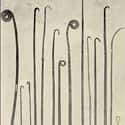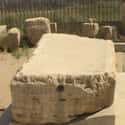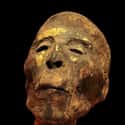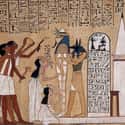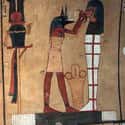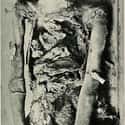-
(#4) There Were Several Ways To Remove Internal Organs
The process an embalmer undertook varied based on the option chosen by an individual's family. First, the brain was removed through the nose using a hook. Next, the organs in the torso were taken out using "a sharp stone of Ethiopia." They also removed the lungs, stomach, liver, and intestines, leaving the heart because they believed that was the center of a person's soul and identity. The organs were placed into canopic jars. The cavity was cleaned with palm wine and spices and was filled with myrrh and cassia before being sewn back together.
Those who desire the middle way and wish to avoid great cost they prepare [it] as follows: having filled their syringes with the oil which is got from cedar-wood, with this they forthwith fill the belly... and this they do without having either cut it open or taken out the bowels, but they inject the oil by the breech, and having stopped the drench from returning back they keep it then the appointed number of days for embalming, and on the last of the days they let the cedar oil come out from the belly, which they before put in; and it has such power that it brings out with it the bowels and interior organs of the body dissolved; and the natron dissolves the flesh, so that there is left... only the skin and the bones. When they have done this, they give back the [cadaver] at once in that condition without working upon it any more.
At the lower end of the embalming spectrum, "They cleanse out the belly with a purge and then keep the body for embalming during the 70 days, and at once after that, they give it back to the bringers to carry away."
In either of the lower-tier options, the organs were given much less care, but they were still placed into canopic jars.
-
(#5) Water, Oil, And Salt Were At The Core Of Any Good Embalming
The process changed over time, but cleaning, drying, and purifying the body were fundamental to the procedure. Water was used to wash the body and was mixed with natron to eat away the flesh. The process was potentially harmful to the embalmers, as well - natron could be hard on the skin, eyes, and lungs.
Natron, a naturally occurring mineral salt made of sodium carbonate, was used to dehydrate the body. Once all the organs were removed from the torso, it was covered with natron and set aside for roughly 40 days. They were placed on tilted tables, so fluid would drain into awaiting containers. Evidence indicates workers used sodium chloride, or common salt, as well. During the earliest days of mummification, bodies were also covered in sand to dry naturally.
According to Diodorus Siculus, writing in the 1st century BCE, "When [embalmers] gathered for the treatment... one of them reaches with his hand through the incision into the thoracic cavity and removes everything but the kidneys and the heart. Another cleans every single piece of viscera by rinsing it with palm wine and fragrant water." Afterward, "The whole body is carefully anointed, first with cedar oil and the like."
No one knows how much of these items embalmers used; however, thanks to the find at Saqqara, archaeologists now "have oils and measuring cups - all of them are labeled... from this we can find the chemical composition of the oils and discover what they are."
-
(#3) The Process Took About 70 Days
According to Herodotus, embalming took 70 days. He described the process after the worker had cleaned the body and removed its organs:
They keep it for embalming covered up in natron for 70 days, but for a longer time than this it is not permitted to embalm it; and when the 70 days are past, they wash the [cadaver] and roll its whole body up in fine linen cut into bands, smearing these beneath with gum, which the Egyptians use generally instead of glue.
This is somewhat misleading, however, because there were other steps required for preservation. Other sources also indicate the timeframe could be accelerated. The Mortuary Stela of Priest Psantik from the 6th century BCE describes a man who "spent 42 days under the hand of Anubis, lord of Tazoser."
-
(#6) Fragrances Were Essential To The Process For Several Reasons
The inclusion of frankincense, myrrh, cinnamon, cassia, and other scented woods and fragrant oils in the embalming process was meant to please the gods. That said, the fragrances must have made the process much more tolerable for the people preparing the bodies, too.
Because anointing the body with oil and perfume was so important to giving it the "odour of a god," it took place at several points during the process. Once the brain was removed, workers poured a mixture of wax, scented oil, and resin into the skull to preserve its shape. The so-called "Ritual of Embalming" involved massaging the body with juniper oil, beeswax, wine, spices, and milk before the abdominal incision was closed. It was also covered in oil from shoulders to feet during the Opening of the Mouth ceremony when the mouth was reopened so the individual could eat in the afterlife.
-
(#11) Professionals Were Organized Into Subsets And Unionized
Herodotus and Diodorus both say embalming was a family profession. As the practice ebbed and flowed in popularity, the demand for embalmers also fluctuated. In their heyday, embalmers formed a union to keep their secrets safe.
Just as there were different levels of embalming, there was also a hierarchy for workers, themselves. Supervisors or hery seshta, known as "masters of secrets," oversaw the process by taking on the role of Anubis (who prepared Osiris's body for the afterlife) and wearing jackal masks.
The khetemu netjer or "seal-bearer of the god" and the khery-hebet or "keeper of the sacred book" called out the appropriate sayings at proper times, while the wetyu prepared the materials. Greek sources later described "incision makers" and "picklers," but there's no Egyptian text that identifies these roles.
-
(#7) Packing The Body Required Attention To Detail
Embalmers had to ensure bodies resembled their pre-dehydrated forms so they would be recognized in the afterlife. Once it was sufficiently dried out, the natron was removed, and it was cleaned again. In some instances, workers would collect detached fingernails, toenails, and hair that had fallen off while the body drained. Then they stuffed body cavities with sawdust, linen, and even sand, creating a lifelike form. They also included scented oils and resins.
It wasn't uncommon for the embalmers to overstuff the head and body. Queen Henuttawy was overstuffed so much that her cheeks burst. Her body was also out of proportion when it was found, although she has since been restored to a more realistic figure.
There were other concerns regarding the materials put in the body. Instructions cautioned workers to "beware lest he be turned upside down onto his abdomen or his face, for his body is filled with medicinal materials, and the gods which are within his abdomen might be displaced from their position." It was just as important to take care that nothing fell out, too.
New Random Displays Display All By Ranking
About This Tool
The whole world is curious about ancient Egyptian mummies, pharaohs, and other historical civilizations. The ancient Egyptians are known for their iconic pharaohs, pyramids, and elaborate tomb rituals, but there are few historical records of Embalmer’s hard life, who paved the way for the sacred ancient Egyptian funeral rituals and carried out a series of preservation work for dead bodies.
With the significant progress made by archaeologists in Egypt, one can speculate about the hard labor of Embalmer mummification, archaeologists excavated the ruins of ancient antiseptic workshops and found some precious historical relics. The random tool shows some ruins and relics that can speculate how a day of an ancient Egyptian embalmer like.
Our data comes from Ranker, If you want to participate in the ranking of items displayed on this page, please click here.











